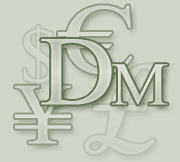 _____ _____ |
| . |
 _____ _____ |
|
|
General Info | Products & Services | Start Trading Today | Current Forex News | Forex Books |
 |
1) Maximize Your Tools Technical Analysis Technical analysis focuses on the study of price movements. Historical currency data is used to forecast the direction of future prices. The premise of technical analysis is that all current market information is already reflected in the price of that currency; therefore, studying price action is all that is required to make informed trading decisions. The primary tools of the technical analyst are charts. Charts are used to identify trends and patterns in order to find profit opportunities. The most basic concept of technical analysis is that markets have a tendency to trend. Being able to identify trends in their earliest stage of development is the key to technical analysis. Fundamental Analysis Fundamental analysis focuses on the economic, social and political forces that drive supply and demand. Fundamental analysts look at various macroeconomics indicators such as economic growth rates, interest rates, inflation, and unemployment. However, there is no single set of beliefs that guide fundamental analysis. There are several theories as to how currencies should be valued. Currency prices reflect the balance of supply and demand for currencies. Two primary factors affecting supply and demand are interest rates and the overall strength of the economy. Economic indicators such as GDP foreign investment and the trade balance reflect the general health of an economy and are therefore responsible for the underlying shifts in supply and demand for that currency. There is a tremendous amount of data released at regular intervals, some of which is more important than others. Data related to interest rates and international trade is looked at the closest. Interest Rates If the market has uncertainty regarding interest rates, then any bit of news regarding interest rates can directly affect the currency markets. Traditionally, if a country raises its interest rates, the currency of that country will strengthen in relation to other countries as investors shift assets to that country to gain a higher return. Hikes in interest rates, however, are generally bad news for stock markets. Some investors will transfer money out of a country's stock market when interest rates are hiked, causing the country's currency to weaken. Which effect dominates can be tricky, but generally there is a consensus beforehand as to what the interest rate move will do. Indicators that have the biggest impact on interest rates are PPI, CPI, and GDP. Generally the timing of interest rate moves are known in advance. They take place after regularly scheduled meetings by the BOE, FED, ECB, BOJ, and other central banks. International Trade The trade balance shows the net difference over a period of time between a nation's exports and imports. When a country imports more than it exports the trade balance will show a deficit, which is generally considered unfavorable. For example, if U.S dollars are sold for other domestic national currencies (to pay for imports), the flow of dollars outside the country will depreciate the value of the currency. Similarly if trade figures show an increase in exports, dollars will flow into the United States and appreciate the value of the currency. From the standpoint of a national economy, a deficit in and of itself is not necessarily a bad thing. However, if the deficit is greater than market expectations then it will trigger a negative price movement. Technical Analysis or Fundamental Analysis? Most traders with FXCM abide by technical analysis because it does not require hours of study. Technical analysts can follow many currencies at one time. Fundamental analysts, however tend to specialize due to the overwhelming amount of data in the market. Technical analysis works well because the currency market tends to develop strong trends. Once technical analysis is mastered, it can be applied with equal ease to any time frame or currency traded.  Today traders with or without experience can benefit from trading with the FX Trading Robot. Psychology of Trading Cut your losses early and Let your Profits Run: This simple concept is one of the most difficult to implement and is the cause of most traders demise. Most traders violate their predetermined plan and take their profits before reaching their profit target because they feel uncomfortable sitting on a profitable position. These same people will easily sit on losing positions, allowing the market to move against them for hundreds of points in hopes that the market will come back. In addition, traders who have had their stops hit a few times only to see the market go back in their favor once they are out, are quick to remove stops from their trading on the belief that this will always be the case. Stops are there to be hit, and to stop you from losing more then a predetermined amount! The mistaken belief is that every trade should be profitable. If you can get 3 out of 6 trades to be profitable then you are doing well. How then do you make money with only half of your trades being winners? You simply allow your profits on the winners to run and make sure that your losses are minimal. Do not marry your trades: The reason trading with a plan is the #1 tip is because most objective analysis is done before the trade is executed. Once a trader is in a position he/she tends to analyze the market differently in the “hopes” that the market will move in a favorable direction rather than objectively looking at the changing factors that may have turned against your original analysis. This is especially true of losses. Traders with a losing position tend to marry their position, which causes them to disregard the fact that all signs point towards continued losses. Do not bet the farm: Do not over trade. One of the most common mistakes that traders make is leveraging their account too high by trading much larger sizes than their account should prudently trade. Leverage is a double-edged sword. Just because one lot (100,000 units) of currency only requires $1000 as a minimum margin deposit, it does not mean that a trader with $5000 in his account should be able to trade 5 lots. One lot is $100,000 and should be treated as a $100,000 investment and not the $1000 put up as margin. Most traders analyze the charts correctly and place sensible trades, yet they tend to over leverage themselves. As a consequence of this, they are often forced to exit a position at the wrong time. A good rule of thumb is to trade with 1-10 leverage or never use more than 10% of your account at any given time. if it was, everyone would be a millionaire! ___________________________________________________ |
||||||||||||||||||||||||||
| Home | General Info | Products & Services | Start Trading Today | Current Forex News | Forex Books |